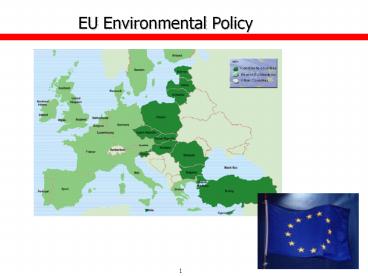EU Environmental Policy - PowerPoint PPT Presentation
Title:
EU Environmental Policy
Description:
Extents authority of EU Parliament in environmental policy. 3. European Institutions ... European Parliament. European Court of Justice (ECJ) 4. EU ... – PowerPoint PPT presentation
Number of Views:26
Avg rating:3.0/5.0
Title: EU Environmental Policy
1
EU Environmental Policy
2
EU Environmental Policy
- Treaty of Rome 1957 (Art. 100)
- Single European Act 1981 (Arts.130r, 130s,
130t,100a) - Environmental protection component of EC policy
- Maastricht Treaty 1992
- Precautionary principle
- qualified majority voting
- Treaty of Amsterdam 1997
- Principle of sustainable development
- Integrate environmental consideration in other
issue areas - Extents authority of EU Parliament in
environmental policy
3
European Institutions
- European Commission (DG Environment)
- Council of Ministers
- European Parliament
- European Court of Justice (ECJ)
4
EU Environmental Policy Instruments
- Regulations Take effect on date specified in
them or 20 days after official publication - Regulation (3528/86) Protection of Forests
Against Atmospheric Pollution - Regulation on the evaluation and control of the
risks of existing substances (1993) - Directive Have to be transposed in national laws
(usually within 2 years) - -Directive 2003/87/EC establishing a scheme for
greenhouse gas emission allowance trading within
the Community - -Large Combustion Plant Directive (1988, 2001)
- -DIRECTIVE 2001/81/EC on national emission
ceilings for certain atmospheric pollutants - Subcidiarity principle actions are taken at the
EU level only if they cannot be undertaken more
efficiently at the local level
5
Large Combustion Plant Directive (1988) Emissions
Limits
Thermal capacity (MW) SO2 (Mg/Nm3) Desulfurization rate () NOx (Mg/Nm3) Dust (Mg/Nm3)
1. Solid fuels 50-100 2000 650 100
100-500 2000-400 40 (100-167 MW) 40-90 (167-500 MW) 650 100
gt500 400 90 650 50
2. Liquid fuels 50-300 1700 450 50
300-500 1700-400 linear decrease 450 50
gt500 400 450 50
3. Gaseous fuels 350 5
3.1 Gaseous fuels in general 35
3.2 Liquefied gas 5
3.3 Low calorific gases 800
Source European Council 1988, Directive
88/609/EEC, Annex III-VIII
6
Areas of EU Environmental Policy
- General
- Air
- Water
- Waste
- Chemicals
- Biodiversity
- Biotechnology
- Noise
- Industrial risk
- Integrated pollution control
- Eco-labeling and audits
- Climate
- Over 400 pieces of legislation altogether
http//europa.eu.int/comm/environment/policy_en.ht
m
7
Why No Race to the Bottom?
8
Expanding the EU Environmental Mandate
- Market integration drives policy integration
(functionalist logic) - Trade and environment conflicts
- barriers to the functioning of the common
internal market - transaction cost considerations
- ECJ rulings as focal points for new regulations
- EU institutions and institutional rules
- Examples
- Chemical safety policies (US lead, the EC
followed because of trade interests) - Auto emission standards (California, Germany, EC
standards) - Danish beer bottle case
- Danish ban on cans, require reusable bottles
- ECJ 1988 ruled trade restriction on environmental
grounds are justified provided they do not
discriminate unfairly - Directives on beverage containers and on
packaging and waste - Most of the environmental acquis related to the
common market
9
Expanding the EU Environmental Mandate
- Exporting domestic regulations (political
logic) - Domestic regulations provide incentive to
harmonize at EU level (avoid competitive
disadvantage, promote domestic regulatory style
and technology - Examples
- Integrated Pollution Prevention Control
- issue permits to large industrial resources
- -minimize pollution in air, water, land waste
minimization and efficiency (UK approach), - -Best Available Technology Not Entailing
Excessive Cost (BATNEC) in as well. - Large Combustion Plant Directive
- command and control (German Approach)
- technology based standards
- Denmark tried exporting eco tax on fuels, but
proposal killed.
10
Expanding the EU Environmental Mandate
- Environmental concern (political logic)
- Commission as agenda setter
- Role of environmental leaders (Germany,
Netherlands, Sweden, Denmark, Austria, Finland,
UK more recently) - The green accession of Sweden, Denmark,
Austria, Finland - The EU Acidification strategy stricter Large
Combustion Plant Directive (2001) National
Ceilings (2001). Took 4 years to negotiate - Public advocates
- Environmental Impact Assessment Directive
- Food safety and GMOs
- EU business
- Well organized at the European Union levels
- Influences negotiations both through governments
as well as through the Commission
11
Implementation of EU Environmental Policy
- Is the glass half empty or half full?
- Mechanism of enforcement
- Police control by the European Commission
monitoring of compliance - Fire alarms complaints to the European
Commission cases for non-compliance with EU law
can be raised at national courts - Mechanisms of environment management or norm
and policy diffusion - Capacity building (twinning)
- Information and shaming
- Subsidization of environmental infrastructure
- More flexibility
12
Future of EU Environmental Policy
- Would the accession of poorer Central and East
European States dilute EU environmental policy? - Areas of leadership in IR
- Climate
- Biotechnology
- Chemicals regulation
- Waste minimization
- Biodiversity?
- Transnational organization of actors play a
growing role (environmentalists, business,
science, bureaucrats) - Issues of policy integration (agriculture,
transport, energy) still unresolved, on the
agenda
13
Challenges of EU Accession and the Environment
- Unequal economic development
- Structural reforms and unemployment
- Weak administrative capacity
- High cost of environmental regulations (est. EUR
120 bn over 10 years) - Environment one of most difficult areas for
accession negotiations (European Commission 1997)
14
The Puzzle of Environmental Harmonization
- All closed environment negotiations
- Limited transition periods for implementation
- Is this a case of paper compliance?
15
The Czech Republic Air Emissions, 1990-1997
16
Poland Air Emissions, 1990-1997
17
Bulgaria Air Emissions, 1990-1997































